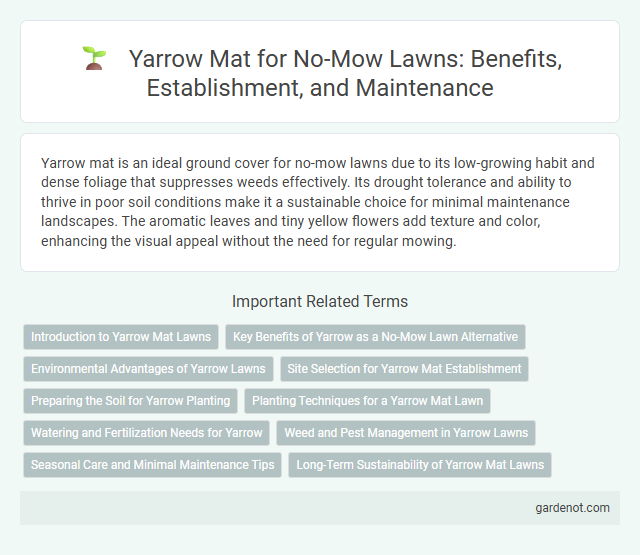Yarrow mat is an ideal ground cover for no-mow lawns due to its low-growing habit and dense foliage that suppresses weeds effectively. Its drought tolerance and ability to thrive in poor soil conditions make it a sustainable choice for minimal maintenance landscapes. The aromatic leaves and tiny yellow flowers add texture and color, enhancing the visual appeal without the need for regular mowing.
Introduction to Yarrow Mat Lawns
Yarrow mat lawns consist of dense, low-growing Yarrow (Achillea millefolium) plants that require minimal mowing and water. This drought-tolerant groundcover forms a resilient, green carpet that deters weeds and supports pollinators with its clusters of small, aromatic flowers. Ideal for sustainable landscapes, Yarrow mats reduce maintenance while enhancing soil health and biodiversity.
Key Benefits of Yarrow as a No-Mow Lawn Alternative
Yarrow mat offers a sustainable no-mow lawn alternative by providing drought tolerance and low maintenance requirements, reducing water usage and mowing frequency. Its dense growth habit naturally suppresses weeds, enhancing lawn health and aesthetics without chemical inputs. Yarrow's deep root system improves soil structure and promotes biodiversity, supporting beneficial insects and pollinators year-round.
Environmental Advantages of Yarrow Lawns
Yarrow lawns significantly reduce water consumption due to their drought-resistant nature, making them an eco-friendly alternative to traditional grass. Their deep root systems improve soil aeration and prevent erosion, fostering healthier ecosystems. Yarrow also supports biodiversity by attracting pollinators like bees and butterflies, contributing to sustainable garden habitats.
Site Selection for Yarrow Mat Establishment
Yarrow mat thrives in well-drained, sandy to loamy soils with full sun exposure for optimal growth. Selecting a site with minimal shade and moderate moisture ensures dense, healthy mats that suppress weeds effectively. Avoid waterlogged or compacted areas to prevent root rot and promote robust establishment of yarrow mats in no-mow lawns.
Preparing the Soil for Yarrow Planting
For optimal Yarrow growth, prepare the soil by loosening it to a depth of at least 6 inches to enhance root penetration and drainage. Incorporate organic matter such as compost or aged manure to improve soil fertility and moisture retention. Ensure the soil pH ranges between 6.0 and 7.0, as Yarrow thrives best in slightly acidic to neutral conditions.
Planting Techniques for a Yarrow Mat Lawn
Planting a yarrow mat lawn requires well-drained, sandy or loamy soil with full sun exposure to ensure optimal growth and drought resistance. Space yarrow plants 6-12 inches apart in a staggered grid pattern to encourage dense mat formation and natural weed suppression. Regularly water the plants for the first 2-3 weeks to establish roots, then maintain minimal irrigation as yarrow thrives in low-moisture conditions.
Watering and Fertilization Needs for Yarrow
Yarrow mats require minimal watering due to their drought-tolerant nature, thriving in well-drained soils with infrequent moisture. Fertilization needs are low; a light application of balanced, slow-release fertilizer in early spring supports healthy growth without encouraging excessive foliage. Overwatering or excessive fertilization can reduce the plant's resilience and natural pest resistance.
Weed and Pest Management in Yarrow Lawns
Yarrow lawns naturally suppress weeds by forming dense mats that inhibit weed seed germination and growth, reducing the need for chemical herbicides. Its aromatic leaves repel common lawn pests such as aphids and whiteflies, promoting a healthier garden ecosystem. Integrated pest management in yarrow mats capitalizes on these natural defenses, minimizing pesticide use while maintaining vibrant, low-maintenance greenery.
Seasonal Care and Minimal Maintenance Tips
Yarrow mats thrive with seasonal care that includes light trimming in spring to encourage fresh growth and prevent legginess. Minimal maintenance tips include watering during prolonged dry spells and removing any dead foliage to maintain a healthy, dense mat. These practices ensure a vibrant, no-mow lawn that resists weeds and requires minimal intervention.
Long-Term Sustainability of Yarrow Mat Lawns
Yarrow mat lawns enhance long-term sustainability by requiring minimal water and fertilizer inputs due to their drought-tolerant nature and deep root systems. These lawns support soil health through natural nitrogen fixation, reducing the need for synthetic fertilizers and promoting biodiversity. Their low-maintenance characteristics help decrease carbon emissions associated with traditional lawn care equipment.
Yarrow mat Infographic

 gardenot.com
gardenot.com